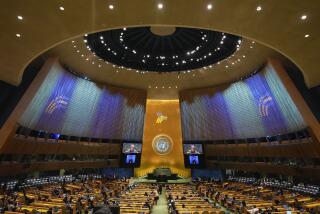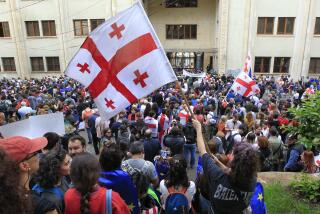The Union Treaty : Redrawing Lines of Power : The completion of a new Union Treaty draft in the Soviet Union marks a key triumph for Gorbachev in his battles against balky republics.
- Share via
MOSCOW — If President Mikhail S. Gorbachev has his way, by this fall the Soviet Union will be transformed from a crumbling empire to a solid--if smaller--federation with a new political foundation.
Winding up marathon talks that Soviet citizens may someday compare to the wrangling of America’s founding fathers, Gorbachev won agreement this week from nine of the 15 current Soviet republics to a new federal treaty meant to hold the country together.
Although the agreement, known as the Union Treaty, will probably not be signed for weeks as recalcitrant republics make up their minds, the completion of the draft treaty marked a key triumph for Gorbachev in his battles against the reawakened nationalism that has beset his tenure.
In theory, the treaty will end the pervasive battles for control between levels of government that have led to what Soviet pundits call “the paralysis of power”--when nothing can be done because no one is quite sure who has the authority to do it.
In practice, however, officials acknowledge that the treaty is only one step in a process that will take years as the lines between local, republic and central power are painstakingly redrawn.
BACKGROUND: Most of the current Soviet Union came under Russian control during czarist times, and the U.S.S.R. in its current form was formally created by treaty in 1922. Dictator Josef Stalin’s brutal regime suppressed nationalism, as did later leaders. But Gorbachev’s liberalizing reforms unleashed latent nationalist fervor, from violent clashes in the Caucasus Mountain republics to Baltic claims of total republic control over laws and resources. Gorbachev proposed the Union Treaty as a way to stitch together a new consensus.
KEY ISSUES: The treaty, specialists say, is an innovative cross between a U.S.-style federation and a looser confederation along the lines of the European Community. It is tailored to accommodate republics fed up with decades of rule from Moscow and somehow keep the country together at the same time. A few of its main points:
* The country is to be called the Union of Soviet Sovereign Republics, replacing socialist with sovereign.
* All republics are declared sovereign, but then delegate important powers to the central government.
* The central government has exclusive control over protecting the country’s borders and command of the armed forces.
* The central government also issues the country’s single currency and controls its gold and diamond resources, although the republics have a right to share them.
* The central government and the republics jointly determine military and foreign policy and work out common policies on the economy, fuel and energy resources.
* Republics have sole control over land and natural resources.
* Republics also have the right to establish direct diplomatic and trade relations with foreign states.
* Both the central government and the republics will levy taxes, but the republics will have oversight powers on how federal money is spent.
* A new constitutional court is to be created to resolve questions of jurisdiction between republics and the center.
POINTS OF CONTENTION: Critics assert that the treaty tries so hard to please everyone that it comes out mushy, leaving too many spheres under ill-defined joint control.
Among the republics, the Ukraine remains the greatest question mark. The republics that appear to be intent on secession make up less than 10% of the Soviet population, but the Ukraine is the size of France and full of rich black earth and valuable industry.
Leonid Kravchuk, chairman of the Ukrainian parliament, acknowledged last week that the majority of Ukrainians voted in a referendum this March to remain in the Soviet Union but said that does not mean they back the Union Treaty as drafted. “The people said yes to the union, I repeat, the union-- an association of countries each of which is its own master in all respects,” he said. “What we need is a document that would fulfill our wishes.”
Also unclear is the fate of the six republics expected to refuse to sign--Estonia, Latvia, Lithuania, Moldova, Georgia and Armenia. Opposition to the treaty also remains potent among conservatives in the central government.
Despite such objections, the national parliament approved the treaty, as did parliaments of eight of the republics.
OUTLOOK: Once the treaty has been signed, it opens the way for a new Soviet Constitution to be written, probably over the next few months. And once there is a new Constitution, Gorbachev has promised it will be followed by direct elections for the presidency.
If it succeeds, the treaty will make the Soviet Union far more attractive for Western investors who now complain that they get permission for projects at one level of government, only to be torpedoed by another. More importantly, the treaty holds the promise that the Soviet Union can avoid Yugoslavia’s collapse into governmental chaos and ethnic civil war.
6 That Have Refused
Estonia (1), Latvia (2) and Lithuania (3):
Under 1940 Nazi-Soviet pact, three Baltic states were absorbed into Soviet Union in an annexation the U.S. has never formally recognized. Among first republics to begin fight against Kremlin control in late ‘80s, they insist on full independence. Lithuania declared its independence in March, 1990, followed by Estonia and Latvia. They have repeatedly, unsucessfully sought to discuss secession with Moscow.
Moldova (4): With mix of ethnic Moldovans--essentially Romanians--and Russian-speaking minorities--Moldova is deeply split by region and by ethnic group on whether it wants to remain in Soviet Union. Some argue for union with Romania.
Georgia (5): Sunny republic is ruled by Zviad Gamsakhurdia, a former dissident with grudges against the Kremlin and deep streak of nationalism. He wants an independent Georgia--with its own army and Black Sea navy. Moscow also embittered Georgians when Soviet troops killed 19 peaceful demonstrators in Tbilisi, in April, 1989.
Armenia (6): It plans September referendum on whether people want to secede from Soviet Union, so Republic’s president, Levon Ter-Petrosyan, has reserved judgment on Union Treaty.
The Ukraine
Long known as Soviet breadbasket, this republic has become lynchpin in fate of new Soviet Union. Docile cousins of Russians, Ukrainians now more openly nationalistic. Ukrainian parliament has put off discussing Union Treaty until fall, crushing Gorbachev hope of summer signing. Ukrainian leaders say they are pro-treaty. But Ukraine plans elections for presidency and current leader, Leonid Kravchuk, will be in crowd-pleasing mood this fall. Issue of joining Soviet Union could split Ukraine between pro-Russia East, Europe-oriented Western provinces.
8 For Treaty
A--Russia
B--Byelorussia
C--Azerbaijan
D--Kazakhstan
E--Uzbekistan
F--Turkmenia
G--Tadzhikistan
H--Kirghizia
More to Read
Sign up for Essential California
The most important California stories and recommendations in your inbox every morning.
You may occasionally receive promotional content from the Los Angeles Times.













